- VOLVO CAR GROUP TO UNVEIL CONCEPT ESTATE AT GENEVA MOTOR SHOW
- THE VOLVO CONCEPT COUPÉ – THE NEXT-GENERATION P1800

VOLVO CONCEPT ESTATE
Volvo Car Group will use the Geneva Motor Show to reveal the third in a series of concept cars – the Concept Estate – that continues the widely-admired exterior design language revealed in the first two concepts, but for the first time reveals how the interior of Volvo’s forthcoming models will both look and function.
The Volvo Concept Estate’s most striking interior design feature is its simplicity. The traditional selection of buttons and controls have been replaced by one large tablet-like touch screen control panel in the centre console, bringing the interior firmly into the 21st century.
“The basic idea is to organise controls and information in a perfectly intuitive and user-friendly way. Everything is exactly where you expect it to be, making the drive more enjoyable, efficient and safe,” says Thomas Ingenlath, Senior Vice President Design at Volvo Car Group.
In association with Volvo’s specially designed software, the touch screen will be the main control panel for Volvo’s new in-car user experience. It replaces all buttons and controls except for a few crucial functions such as volume, play/pause, hazard warning and window heaters. It also interacts seamlessly with the digital instrument cluster in front of the driver.
“Not having to deal with buttons and controls for a growing number of functionalities is like being freed from a pair of handcuffs,” says Robin Page, Design Director Interior of Volvo Car Group. “This has made it possible to build a beautiful interior architecture around the portrait screen. The concept car showcases how this user interface will be integrated in our new car generation.”
Volvo is the company that redefined the Estate car by combining functionality, sturdiness and practicality with performance. The V70 and XC70 are among the most respected Estates on the market and the new Concept Estate points to how the company could capitalise on this heritage in its forthcoming models.
Volvo has been on a winning streak with its concept cars. The Concept Coupé was named ‘Car of the Show’ by a leading German auto magazine at the Frankfurt Motor Show, while the Concept XC Coupé received the prestigious ‘Eyes ON Design’ award at the Detroit Motor Show.
Global attention on Volvo’s concept cars has been intensifying as they provide the first significant clues as to how the all-new and much-anticipated XC90 SUV and subsequent cars will look. The XC90 is due to be launched later this year.
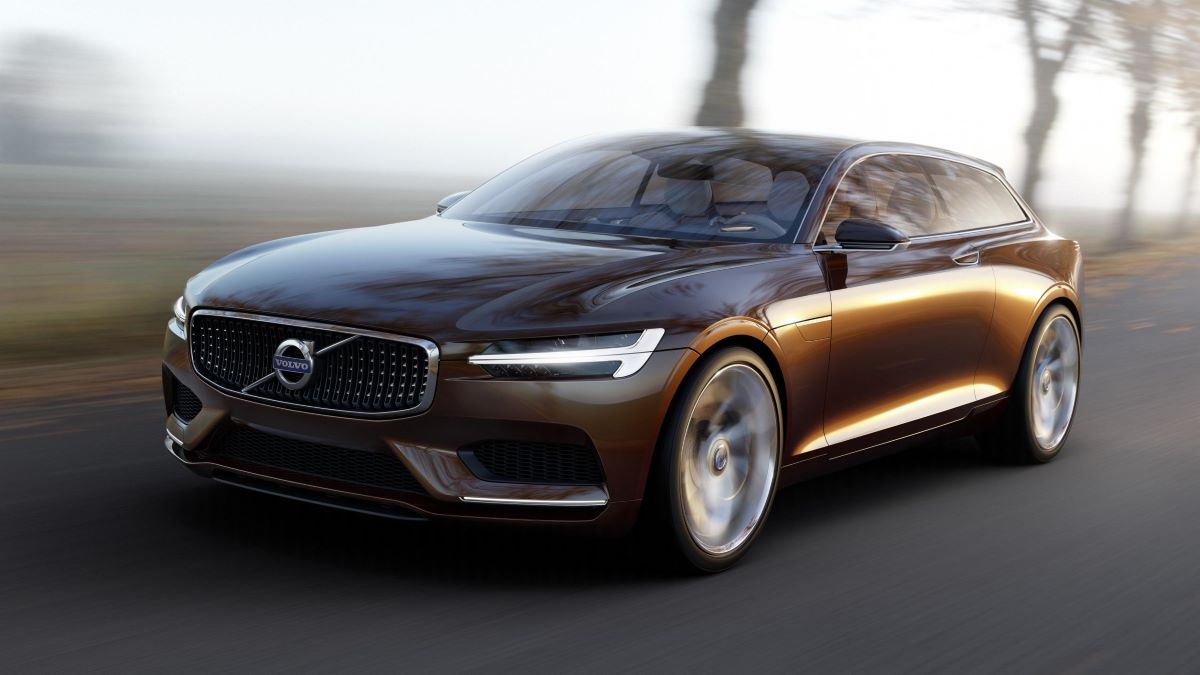
Learning from history
The rear of Concept Estate echoes the design of the Volvo 1800 ES from the early 1970s.
“The 1800-models are iconic Volvos, renowned for their beautiful forms and detailing. However, using elements from their exterior and interior has nothing to do with being retro. We are using these subtle links to a glorious past to create a future in which sheer beauty becomes a recognised part of Volvo’s identity,” says Thomas Ingenlath.
The subtle inspiration from the 1800-models is also evident on several details inside the Concept Estate, such as the two-spoke steering wheel, the instrument panel and the dials.
Robin Page explains: “The first four decades of the Volvo history was characterised by classic craftsmanship and high quality materials. We are merging this vital part of our brand DNA with the more recent focus on technology and smart functionality. In the Concept Estate we also add the creative side of Scandinavia. The result is an exotic interior with genuine materials and beautiful detailing.”
Beautiful and different
Applying this approach to the iconic estate car – which is the essence of versatile Volvo functionality – creates a car that is both beautiful and different.
The generous dash to axle ratio, low bonnet, sleek silhouette and the glass roof all contribute to the impression of a dynamic, yet capable three-door sports wagon. The contrast between the deep, dark brown pear colour and the bright five-spoke, 21-inch wheels contributes to the modern, cool aura.
Just like the recent Concept Coupé and the Concept XC Coupé, the face of the Volvo Concept Estate is characterised by a new topography on the bonnet and the ‘floating’ grille, flanked by headlights featuring new T-shaped DRL light guides. The rear light signature is another distinctive element in Volvo Cars’ new design direction.

Swedish inside and out
Extrovert and colourful trends within contemporary Swedish lifestyle and design have been powerful sources of inspiration for the design team. Occupants in all four seats are embraced by orange seat belts, and the exclusive, woven wool carpets from the Swedish designer Kasthall have the same deep accent colour.
The crystal gear leaver from Orrefors/Kosta Boda also has an orange glow, while the chequered black and white wool textile on the headliner and rear sides of the front seats adds playfulness to the ‘room’.
“Creativity is thriving in Swedish society. This includes design and technology as well as the fashion, music and art scene. We have used all this as inspiration to create a new, exciting way to express Sweden’s soul,” says Thomas Ingenlath.
The feel of a Scandinavian living room
Refined, handcrafted details, such as an instrument panel covered by thick, naturally tanned saddle leather from Tärnsjö, inlays made of waxed, naturally aged wood and machined copper details, also emphasise the exclusive Swedish atmosphere inside Concept Estate.
“The interior is exceptionally vivid. Yet the glass roof and seats covered by light, soft Bridge of Weir leather help to retain that bright and cosy feeling that is the hallmark of a Swedish living room. A place that makes you feel so comfortable that you are reluctant to leave,” says Robin Page.
Specially designed Swedish ‘kubb’ game
The ambiance might inspire occupants to stop for a picnic and game of Swedish “kubb”. The specially designed game set is visible through the load floor in the back.
“Don’t know the rules? No problem. They are printed on the transparent floor. And rain is no excuse. You will find exclusive Stutterheim raincoats in the back of the car as well,” explains Robin Page.
Volvo’s Partner Suppliers in the creation of the Concept Coupé, Concept XC Coupé and Concept Estate:
Tyres: Pirelli
Wheels: Uniwheels
Leather: Bridge of Weir
Exterior paint: Axalta Coating Systems
Carpet: Kasthall
Gear shift: Kongsberg
Gear shift glass: Orrefors
Exterior light: Valeo
Belts: Autoliv
Interior ambient light: 3M
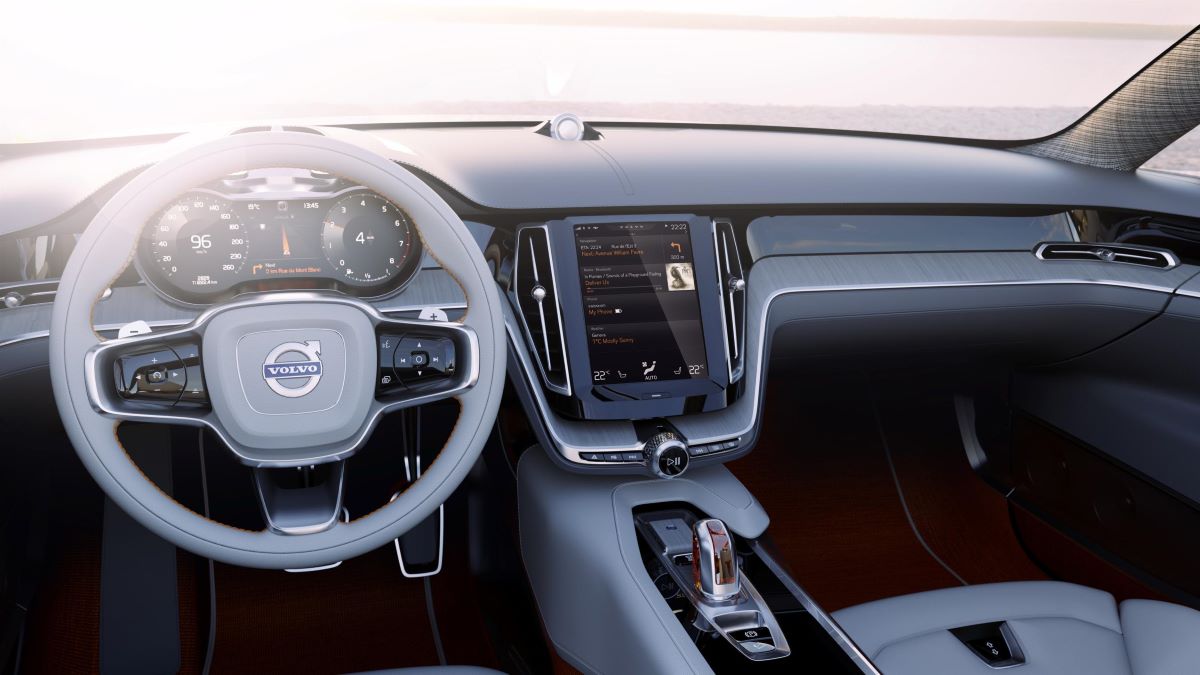
DESIGN AND TECHNOLOGY AT THE HEART OF VOLVO CAR GROUP’S NEW IN-CAR EXPERIENCE
Sleek Scandinavian design and intuitive technology to reinvent the car interior.
Volvo Car Group will use the Geneva Motor Show to reveal its new in-car control system, which is designed around a large tablet-like touch screen that will simplify and enhance the way drivers operate their cars.
The touch screen replaces the traditional selection of buttons and controls in the centre stack with one clean and sleek control panel. It will blend established tablet functionality, such as swiping and pinching, with new solutions that are specially designed for the in-car environment. It also interacts with the digital instrument cluster in front of the driver.
“The basic idea is to organise controls and information in a perfectly intuitive and user-friendly way. Everything is exactly where you expect it to be, making the drive more enjoyable, efficient, and safe,” says Thomas Ingenlath, Senior Vice President Design at Volvo Car Group.
This ground-breaking driver experience will be introduced in the next car generation, starting with the all-new Volvo XC90 later in 2014.
“The new user interface is designed to create a smooth, logical and safe interaction between the driver and the car,” says Thomas Ingenlath. “This goes far beyond just putting a large tablet in the centre of the dashboard. We have created a digital environment that is fully integrated in the car.”
Logical stack of four ‘tiles’
The layout on the portrait screen can be described as a stack of flexible ‘tiles’, each displaying a key functionality. Navigation is on the top, followed by media and telephone.
A thin notification band is located above the tiles, while the digital climate controls become the ‘foundation’ of the pile.
“Information, navigation and media are high up and easy to keep an eye on. The phone controls, application icons and climate controls are located low, comfortable to reach and touch. Using the screen is so logical that it will be part of your muscle memory very quickly,” explains Thomas Ingenlath.
The smooth user interface also includes thumb-reach controls on the steering wheel and extensive voice-control possibilities.
Digital solution
The new user interface is designed so that the tiles on the touch screen expand on interaction. When one of the tiles expands to display required information, the others are compressed, still visible and instantly accessible.
“Having all functions present all the time makes the touch screen exceptionally user-friendly. The spacious layout also promotes smooth interaction without distraction,” says Thomas Ingenlath.
Crystal clear but calm
“Creating this crystal clear, yet calm, environment is a core part of our digital craftsmanship. It is fine for an ordinary tablet to fight for your full attention but a touch screen in a car is very different. Information must be clear and user-friendly, without turning up the visual volume so much that you risk losing focus on the road. This also makes it easier to make really urgent information, such as a warning, much more distinctive,” concludes Thomas Ingenlath.
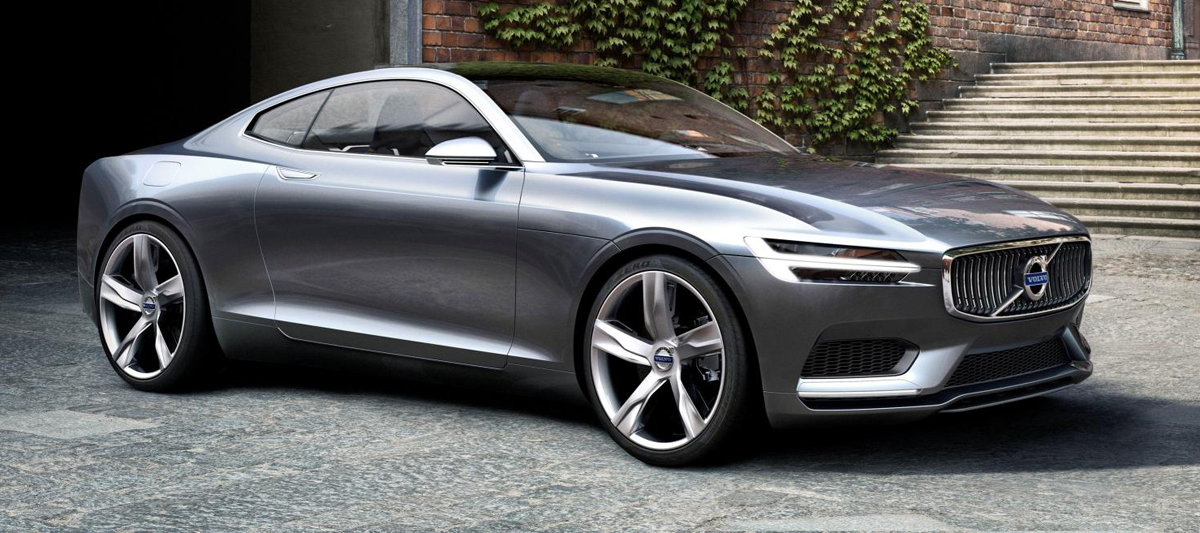
VOLVO CONCEPT COUPÉ P1800
Inspired by contemporary, progressive Scandinavian lifestyle and design as well as iconic elements from the past, the elegant new Volvo Concept Coupé is the first of a series of three concept cars that reveal the design possibilities created by the company’s new Scalable Product Architecture (SPA).
After a more than a year of rising expectations, the first design by the new Senior Vice President of Design, Thomas Ingenlath, showcases how design builds emotion into the Volvo brand and points toward the next generation of Volvo models, starting with the forthcoming XC90 in 2014.
“The Volvo Concept Coupé is no futuristic dream car. It is designed to demonstrate the capability of our new architecture: the confident stance, the proportions and the most prominent design signatures. Even though the all-new XC90 is an entirely different type of car, you will recognize the connection instantly when it is revealed next year,” said Ingenlath.
Developed in-house for Volvo Cars only, the Scalable Product Architecture liberates Volvo’s designers and engineers from the limitations of previous cross-brand platforms.
“The new Volvo Concept Coupé reveals how we could shape our cars from now on. Free from the superficial surface excitement of other car brands, we add emotional value to the Volvo brand with the calm, confident beauty that is the hallmark of Scandinavian design,” says Thomas Ingenlath.

Powerful visual impact
The visual impact of the new proportions is most powerful when viewing the Volvo Concept Coupé from the side. The distance between the dashboard and the front axle is extended and the greenhouse has been moved slightly rearwards.
A low hood, roof, and the five-spoke, 21-inch wheels also contribute to the impression of an elegant Gran Tourer oozing effortless power. The confident stance is emphasized by a beltline that spans an elegant bow along the whole car.
“Think about the powerful calmness of a lion. He doesn’t have to prowl to radiate respect. Even lying down he shows very clearly what he is capable of,” smiles Ingenlath.
New T-shaped Daytime Running Lights
The face of the Volvo Concept Coupé is characterized by a new topography on the hood and the ‘floating’ grille, flanked by headlights featuring new T-shaped daytime running lights guides. Just like the rear light signature, the daytime running lights are distinctive elements in the new design direction of Volvo Cars.
“The face is new, but it also carries more than 85 years of Volvo heritage with great pride. We are still working with the final interpretation of the grille and the iron mark and this will be revealed together with the XC90 next year,” said Ingenlath.
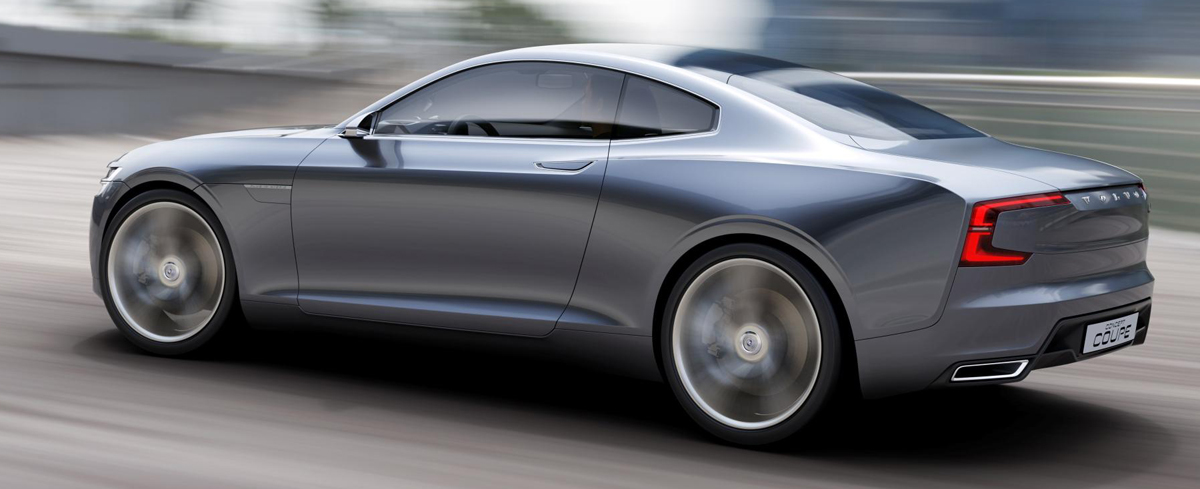
Echoes the iconic P1800
The Concept Coupé also features elements that echo the design of the Volvo P1800 from the 1960s.
“It is a car designer’s duty to reflect and incorporate design signatures that are vital parts of the company’s heritage. The P1800 is an iconic Volvo, renowned for its beautiful forms and detailing. However, using elements from the P1800 exterior and interior has nothing to do with being retro. We are using these subtle links to a glorious past to create a future where sheer beauty becomes a recognized part of Volvo’s identity. That journey starts with Concept Coupé,” said Ingenlath.
Sparkling crystal gear-leaver
The blue-grey exterior is echoed on the inside of the Volvo Concept Coupé. Refined, handcrafted elements such as the leather instrument panel, inlays made of naturally aged wood and the dark blue woven carpets are blended with beautifully machined metal details.”
“To me, handcrafted crystal is one of the finest examples of high-quality Scandinavian design and I love the idea of bringing it into the car. The prominent position of the gear-leaver is the perfect place for this sparkling sensation,” said Robin Page, Design Director Interior at Volvo Car Group. He adds: “The experience inside Concept Coupé is an excellent example of how we will make Volvo customers feel truly special.”
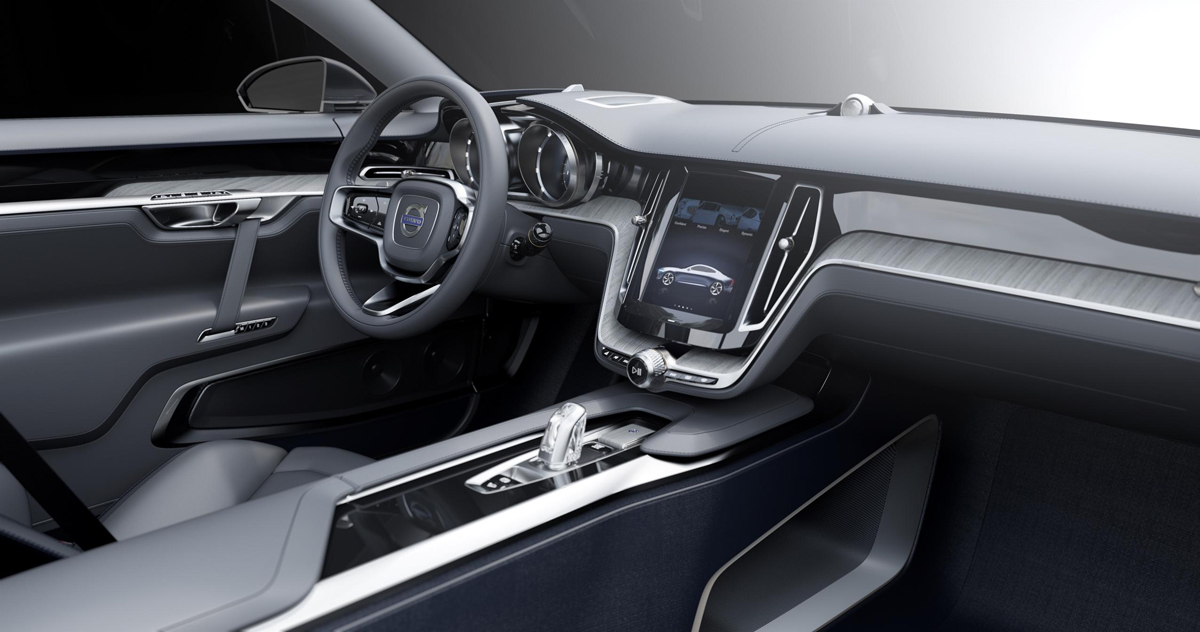
Large portrait touch-screen
The concept car also includes a totally new approach to Volvo Cars’ human-centric user experience. A large portrait touch-screen in the center console interacts with an adaptive digital display and head-up display in front of the driver.
“This is a natural integration of user interfaces in our new car generation. Interaction with pleasure but without distraction is the key. We bring connectivity into our cars to make them both more enjoyable and safe,” explains Ingenlath.
The Scalable Product Architecture is also being prepared for completely autonomous driving. The first features with autonomous steering to avoid accidents and make driving more comfortable will be introduced in 2014 – and Volvo Cars’ aim is to have cars with fully autonomous technology out on the roads before 2020.
Gasoline plug-in hybrid – powerful and efficient
The gasoline plug-in hybrid driveline in the Volvo Concept Coupé reflects Volvo Cars’ strategy to use electrification to create the most powerful versions in the new four-cylinder Drive-E engine family. This will take power figures up into V8 territory.
The concept car features a two-liter high-performance Drive-E gasoline engine with a supercharger and turbo. The petrol engine is teamed with an electric motor on the rear axle. This gives Volvo Concept Coupé a total output of around 400 hp and over 440 lb.-ft. of torque.

NEW DESIGN DIRECTION INJECTS EMOTION INTO VOLVO’S TRANSFORMATION JOURNEY
The Volvo Concept Coupé is the first expressive interpretation of a new brand direction where design has an elevated strategic importance to deliver more emotion into the Volvo brand.
“Our transformation plan includes a commitment to create a more premium vision of Volvo Cars. Releasing the emotional power of our human-centric design heritage is one of the key elements in this strategy,” said Alain Visser, Senior Vice President Marketing, Sales and Customer Service at Volvo Car Group. He adds: “A more premium image is vital to gain momentum in our journey toward an annual sales volume of 800,000 cars. It also supports our price position versus our main competitors in the premium segments.”
Building on recent success
The introduction of the Volvo V40 in 2012 was the first step in this direction. The positive media and customer feedback emphasizes that Volvo Cars is running with the best in several important areas, including design.
The upcoming introduction of the new scalable architecture enables the company to accelerate the transformation.
The Volvo Concept Coupé is the first of a series of three concept cars that demonstrate the design possibilities created by the new Scalable Product Architecture (SPA). They pave the way for the introduction of the all-new Volvo XC90 in 2014.
Technology as an enabler for emotion
The new in-house developed architecture and engine program are the enablers for a stronger emotional expression of the brand, both when it comes to the exterior design and a new approach to the interior, user interface and connectivity
“Volvo’s unique human-centric approach and the aim to inject more emotions into the car design are perfect partners. Volvo Cars’ caring, human-centric values are an integrated part of the Scandinavian culture and lifestyle. The challenge is to express this with a bolder, more distinctive design that is an all-important customer criteria for premium cars,” said Thomas Ingenlath, Senior Vice President Design at Volvo Car Group.
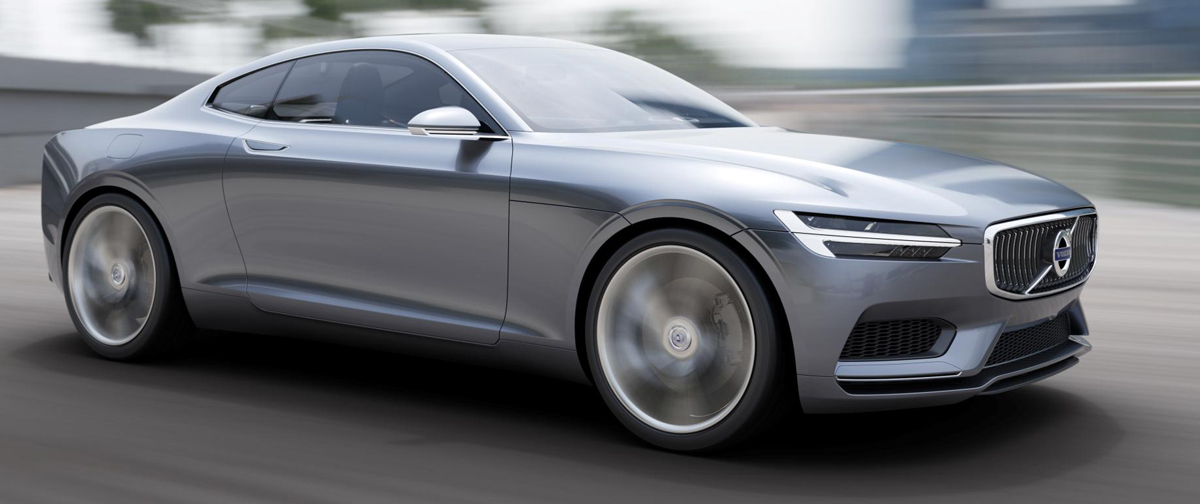
Design creates premium desirability
Truly premium brands are based on a complex mix of rational, qualitative parameters and strong emotional values that create desirability – and there are several examples of brands that have moved from mainstream to premium through a stronger focus on design.
“Case studies of brands that have made a similar journey to ours give us valuable input into the mechanisms that trigger the consumers perception of premium. This, together with our own studies of people’s views of Volvo Cars, becomes a valuable base for our design development,” said Visser.
Rational properties with added emotional value
The emotional aspect is also important when shaping the future of properties that are established Volvo territory among consumers:
- Focus on safety has moved from offering protection in worst-case scenarios to creating features that support the driver and enhance the user experience.
- Modern environmental care is able to combine low emissions and reduced fuel consumption with an enhanced driving experience – for instance though ingenious plug-in hybrid technology.
- The classic functionality has moved beyond being practical. Volvo Cars’ approach is to create human-centric features that actually make today’s hectic life easier for the user.
“Reliable functionality has always been a non-compromise prerequisite for Scandinavian designers. Up here, designs have to deal with a harsh reality that demands meticulous attention to detail and quality,” said Ingenlath. He concludes: “Combining this with a distinctive design language that is inspired by this unique Scandinavian environment will give us a competitive edge that no one of our competitors can match. You could say that we will continue to do what Volvo always has done. We will just do it much better and make it much more emotional.”
